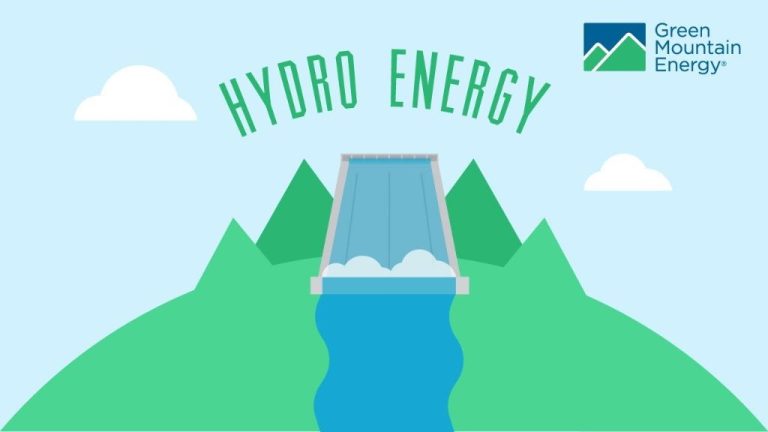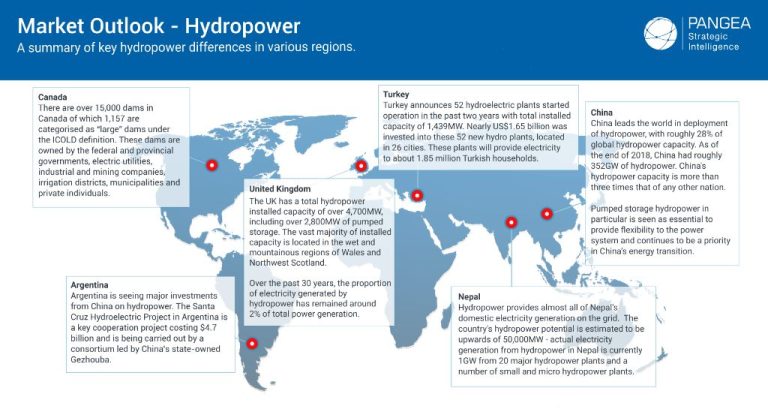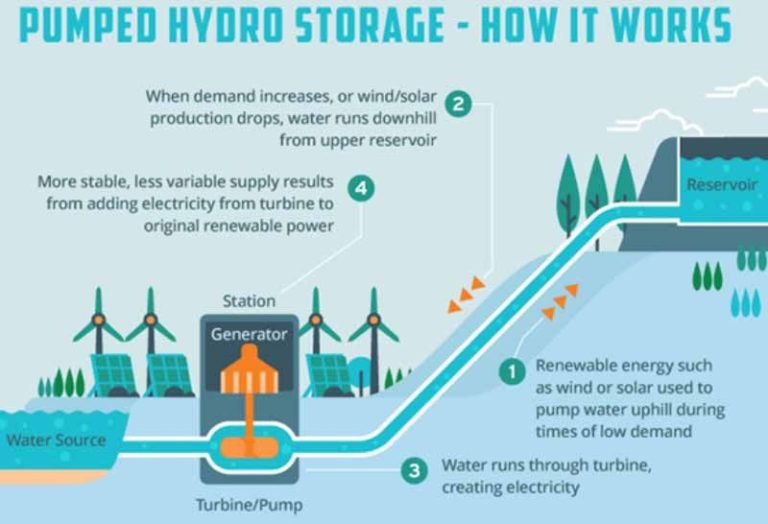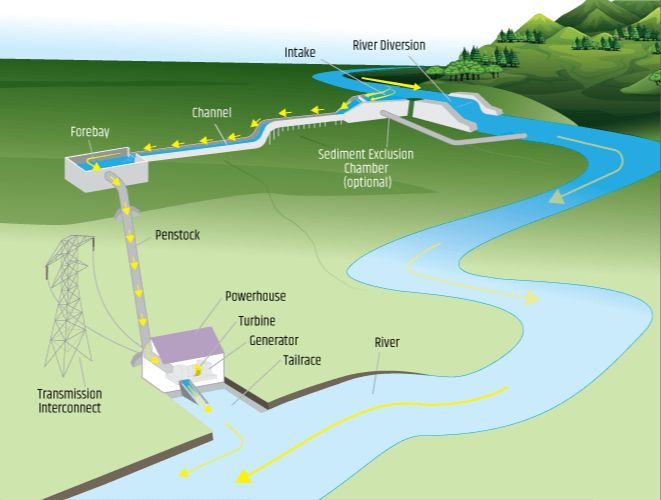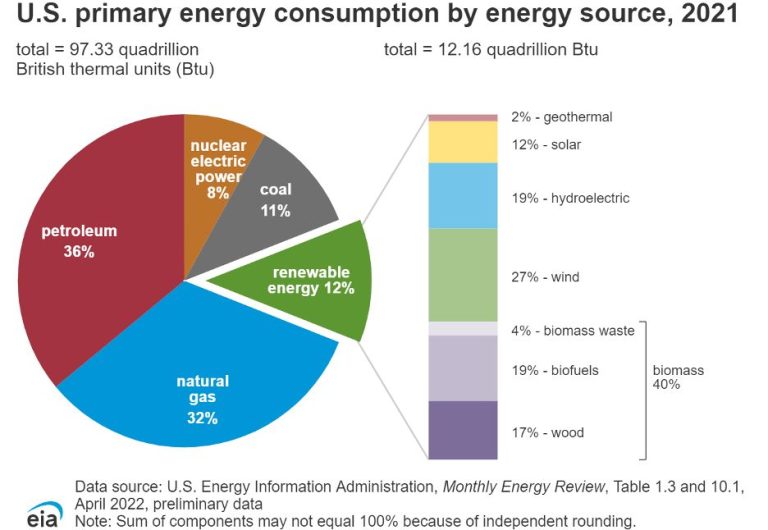What Is A Turbine In Hydropower?
What is a Turbine?
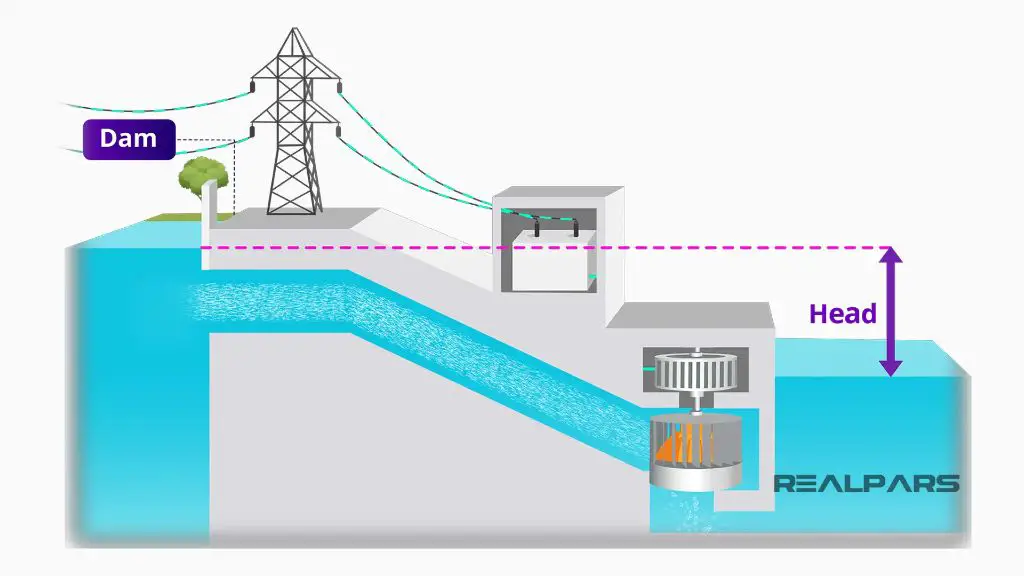
A turbine is a rotary mechanical device that converts the energy of a moving fluid into rotational energy. Turbines are commonly used to generate electricity in power plants by using steam, water, wind, or gas as the moving fluid.
In the context of hydropower, a turbine converts the kinetic energy of moving water into mechanical energy. The mechanical energy produced by the turbine runs a generator to produce electricity. There are two main types of hydropower turbines:
- Impulse turbines – Water is directed at the turbine blades via nozzles to make them spin. Common impulse turbines include Pelton wheels.
- Reaction turbines – The blades are fully immersed in water, and the moving water applies force to them to make them spin. Common reaction turbines include Francis and Kaplan turbines.
The process works like this: First, water from a high elevation flows through pipes and enters the turbine at a high velocity. The moving water strikes the turbine blades, transmitting its kinetic energy to rotate the turbine. The rotational kinetic energy drives the shaft connected to a generator to produce electricity. After passing through the turbine, the water flows out at a lower elevation.
Turbines optimize the conversion of water’s mechanical energy into usable electricity. Well-designed turbines can achieve over 90% efficiency in converting water energy into electrical energy.[1]
History of Hydropower Turbines
The use of water wheels and watermills for mechanical power dates back over 2000 years. Early water wheels converted the kinetic energy of flowing or falling water to rotational mechanical energy to grind grain, saw wood, or perform other work. By the 1800s, engineers developed more advanced water turbines that could convert the energy in flowing water to rotational energy more efficiently.
In 1849, British-American engineer James Francis developed the first modern water turbine, known as the Francis turbine, which remains the most widely used design today (A brief history of hydropower). His design used curved blades that made it more efficient and able to operate under a wider range of water flow conditions. Other key innovations in water turbine designs followed, including the Kaplan turbine in 1913, the Pelton wheel turbine in the 1870s, and the Turgo turbine in 1919.
With the advent of electricity in the late 1800s, hydropower turbines were adapted to generate electrical energy. In 1882, the first hydroelectric power plant opened on the Fox River in Wisconsin, powered by a water turbine. Since then, hydropower expanded greatly to become an important renewable energy source worldwide. Advances in materials, engineering, and technology have enabled modern turbines to achieve greater efficiencies in converting the power of moving water into useful energy.
Types of Hydropower Turbines
There are two main types of hydro turbines: impulse and reaction turbines [1].
Impulse turbines, like Pelton turbines, utilize the velocity of water to move the turbine blades. The water stream hits each bucket on the turbine and is redirected out with very little pressure. Impulse turbines are ideal for high head sites with low flow.
Reaction turbines, like Francis, Kaplan, and Propeller turbines, operate using water pressure and move as water passes through the turbine. Francis turbines are the most common reaction turbine. They operate under a wider range of hydraulic conditions than impulse turbines. Kaplan turbines have adjustable blades and are used in low head sites. Propeller turbines are axial flow reaction turbines that operate well in low head, high flow conditions [2].
Hydraulic Principles
The hydraulic principles that govern the operation of hydropower turbines relate to the conversion of the potential energy of elevated water into kinetic energy to turn the turbine. There are three key parameters:
- Head – The height difference between the water intake and the turbine.
- Flow rate – The volume of water that passes through the turbine per unit time.
- Pressure – The force per unit area exerted by the water on the turbine. This increases with higher head and flow rate.
The potential power available from a hydro resource is calculated using the following equation (source):
Power (Watts) = Head (meters) x Flow Rate (cubic meters/second) x 9.81 (gravitational acceleration)
However, hydropower turbines cannot convert 100% of this available power into electricity. The actual power produced depends on the efficiency of the turbine. Typical turbine efficiencies range from 80-95%. More advanced turbine designs aim to maximize efficiency by optimally harnessing the site’s head and flow characteristics.
Turbine Components
The main components of a hydropower turbine include:
Runner
The runner is the rotating part of the turbine that converts the energy of falling water into mechanical energy. It is connected to the turbine shaft and spins when water strikes its blades or buckets. Common runner designs include Francis, Kaplan, Pelton, and Turgo. Runners are carefully engineered for optimal efficiency based on the turbine type and site conditions.
Shaft
The shaft is a steel rod that connects the runner to the generator. It rotates along with the runner at a constant speed. The shaft must be sturdy enough to transmit the power from the turbine runner to turn the generator rotor and produce electricity.
Wicket Gates
Wicket gates, also called guide vanes, control the flow of water onto the runner blades. They open and close to regulate the speed and power output. Wicket gates allow turbines to vary their output according to electricity demand on the grid.
Casing
The casing houses and protects the runner, wicket gates, and other internal components. It has passages for water inflow and outflow. The casing is custom-designed based on the site layout, available water head, and flow rate.
Together, these components work in harmony to convert the potential energy of water into electrical energy with minimal losses. Proper turbine selection, operation, and maintenance are critical for optimal efficiency and longevity.
Turbine Selection
The optimal turbine for a hydropower site depends on the characteristics of the site, mainly the head height and flow rate. Head height refers to the vertical distance between the water intake and the turbine. Flow rate is the volume of water passing per unit of time. Engineers analyze these factors to determine the best turbine design for the site.
Impulse turbines, like Pelton wheels, work best with high head heights. The water falls from the intake through a nozzle and hits the turbine blades at high velocity. Reaction turbines like Francis and Kaplan designs are better suited for lower heads. They operate fully submerged in the water flow.
The flow rate also impacts turbine choice. Pelton wheels work with lower flow rates. Francis turbines handle moderate flows. Kaplan turbines are most efficient for sites with high flow rates.
Overall, matching the turbine design to the site’s head height and flow rate ensures optimal efficiency. Pelton for high head, low flow. Francis for moderate head and flow. Kaplan for low head, high flow. Proper turbine selection also minimizes environmental impact and costs.
Sources:
https://www.energy.gov/eere/water/types-hydropower-turbines
Turbine Efficiency
The efficiency of a hydropower turbine determines how much of the water’s energy can be converted into electricity. There are several factors that impact turbine efficiency:
Hydraulic design – The specific speed and flow passages of the turbine impact efficiency. Pelton turbines are most efficient at high heads, Francis turbines at medium heads, and Kaplan turbines at low heads [1].
Runner design – Optimizing the turbine runner blades for the site’s specific hydraulic conditions can improve efficiency. Higher efficiency runners have precisely designed curved blades [2].
Operating conditions – Turbines achieve peak efficiency at the design flow rate. Efficiency drops during off-design conditions with lower or higher flows. Matching turbine type to the site’s flow and head is key [3].
Maintenance – Keeping turbines well-maintained, monitoring performance, and rebuilding/replacing components as needed sustains peak efficiency.
Upgrades – Replacing older turbine runners with newer optimized designs can boost efficiency by 2-6% [1].
Environmental Considerations
While hydropower is a renewable energy source, large hydroelectric dams and reservoirs can have significant environmental impacts. Hydropower projects can change natural water flows, increase siltation, impact local wildlife, and require large areas of land to be flooded. However, technological improvements and mitigation measures can help reduce the environmental effects of hydropower turbines.
One way to minimize the impact on fish and other aquatic life is to install fish-friendly turbines. These are designed to allow fish to pass through the turbine safely without getting struck by blades. Fish-friendly designs include minimum gap runners, grooved turbines, and very low operating speeds. Preliminary testing indicates survival rates through these turbines can be over 90%.
Another approach is to use low-impact project designs. This involves building “run-of-river” facilities that divert water without dams or reservoirs, generating power from the natural flow of rivers. Floating solar panels can also be paired with hydropower to reduce the overall footprint. Implementing robust fish passage systems is another key sustainability measure for new projects.
Turbine Manufacturers
There are a number of major companies that manufacture turbines for hydropower plants around the world. Some of the top manufacturers include General Electric, Siemens, Andritz, Voith, and Litostroj Power Group (Mordor Intelligence, 2022).
These large manufacturers have the engineering expertise to handle complex and customized turbine designs for hydropower projects. They utilize state-of-the-art technology like computational fluid dynamics and 3D modeling to optimize turbine performance (Power Technology, 2022).
In addition to the major players, there are many smaller manufacturers that provide turbines for small hydro and micro hydro installations. These companies often specialize in standardized turbine designs that are cost-effective for small projects. Some examples include NuSTREEM, Hitachi Nico Transmission, and Gilbert Gilkes & Gordon (Metoree, 2022).
Custom engineering is important in the turbine manufacturing industry to tailor each design to the specific site conditions and power requirements. Factors like head height, flow rate, and desired output are used to determine the optimal runner design, size, and materials for the turbine.
Future of Hydropower Turbines
The future of hydropower turbines looks bright as new technologies emerge to increase capacity and efficiency. Researchers are developing more advanced turbine designs, including slow-running Kaplan turbines that can operate efficiently over a wider range of water flow conditions. These new turbine types promise gains of 5-20% in annual energy production compared to conventional designs (1).
Another area of innovation is low-head hydropower turbines that can operate in rivers and streams with lower water flows and smaller drops in elevation. Companies like Voith Hydro and GE Renewable Energy are creating new turbine designs optimized for low-head sites. By expanding into these unaugmented rivers, the hydropower industry could see considerable growth in renewable generation capacity (2).
Advancements in materials science and manufacturing are also leading to larger, more durable turbine components. These improvements allow turbines to harness more energy from the water with increased availability and longevity. With smart IoT sensors and data analytics, turbine maintenance can also become more predictive to minimize downtime. The future is bright for more efficient, more flexible hydropower turbines that will boost renewable energy production.

